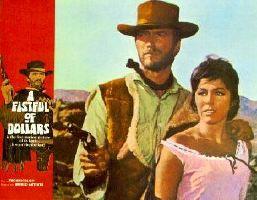Spaghetti westerns and style
I'll get back to my response to The Kingdom of Christ soon. First, however, I can't resist passing along some comments I heard on the radio yesterday, when I happened upon one of Terry Gross's Fresh Air interviews. This time she was speaking with Sir Christopher Frayling, who has now written Once Upon a Time in Italy: The Westerns of Sergeo Leone. Sergio Leone is best known as the creator of the spaghetti western genre, beginning with a film that came out the same year as Billy Wilder's Kiss Me Stupid (see my first post): A Fistful of Dollars (starring Clint Eastwood) in 1964...
 Frayling made a fascinating comment in the few minutes I listened to the interview Noting the optimistic, "white-hat" persona of the cowboy in American westerns, he pointed to director Sergio Leone's grittier, more pessimistic, "gray-hat" portrayal of cowboys. Thus, asked by a boy why he's helping them, Clint Eastwood's character in Leone's A Fistful of Dollars does not give a John Wayne, "a man's-gotta-do-whatta man's gotta do" response. "What are you doing this for?" the boy asks. "Five hundred dollars," comes the hero's response. It wasn't about doing the right thing. It was just about the money. Beginning with Leone's A Fistful of Dollars, Frayling suggests, it wasn't what you believed in that mattered; it was your style.
Frayling made a fascinating comment in the few minutes I listened to the interview Noting the optimistic, "white-hat" persona of the cowboy in American westerns, he pointed to director Sergio Leone's grittier, more pessimistic, "gray-hat" portrayal of cowboys. Thus, asked by a boy why he's helping them, Clint Eastwood's character in Leone's A Fistful of Dollars does not give a John Wayne, "a man's-gotta-do-whatta man's gotta do" response. "What are you doing this for?" the boy asks. "Five hundred dollars," comes the hero's response. It wasn't about doing the right thing. It was just about the money. Beginning with Leone's A Fistful of Dollars, Frayling suggests, it wasn't what you believed in that mattered; it was your style.It was that comment--on the conquest of truth by style--that so grabbed my attention. A similar online quote of Frayling puts it this way: "thanks to the Dollars films, Hollywood action heroes stopped 'being role models and became style statements. You don't identify with them because of what they believe in but because of what they look like.'" And the influence of Leone's spaghetti westerns continues: "Schwarzenegger, Stallone, Bronson, Bruce Willis start here... all that begins with Fistful of Dollars," says Frayling. "Up till then, heroes were supposed to stand for something. That's the spaghetti western's biggest legacy, whatever the genre."
This is, of course, simply another example of our culture's confusion between truth and style, reality and perception. Style is all that matters. Perception is reality. Or, perhaps, in terms of the old Christian triad of the good, the true, and the beautiful, goodness and truth take a back seat to a rather truncated version of beauty, now defined as "style."
Christianity offers a very different vision. In the biblical worldview outer appearances can be deceiving, both because evil can pass itself off as good and beautiful and because what is good must inevitably, since the fall, emerge within a world still marred and scarred by brokenness, pain, ignorance, and sin. It is thus imperative to distinguish, as much as possible, between perception and reality. Indeed, one might even define faith as the ability to see past the perceptions of this age to the goodness, truth, and beauty of the age to come, already making their appearance in the community of those of who follow the crucified and risen Lord.
But that last sentence needs to be unpacked in light of the points Russell Moore raises in The Kingdom of Christ. I'll try to get back to that tomorrow.
Categories: Movies



1 Comments:
Great words on spaghetti western legends. Thank you. Leone would be proud of it.
Post a Comment
<< Home